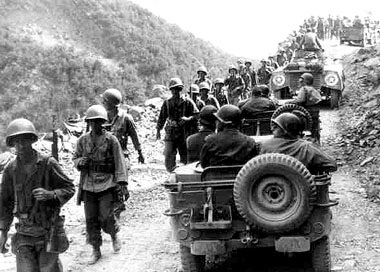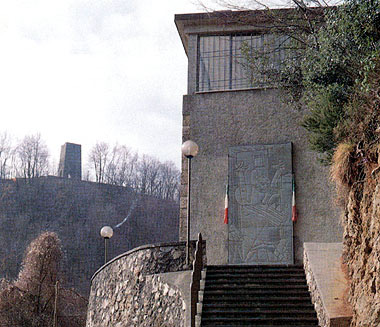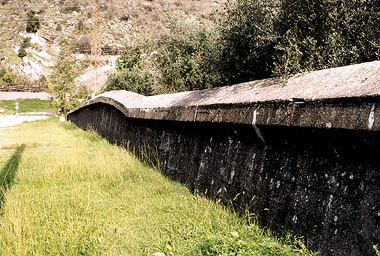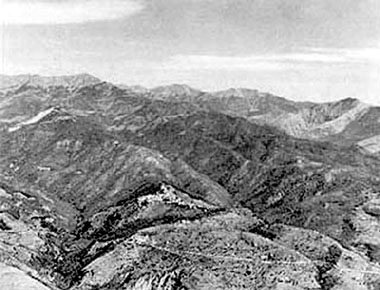Places connected with the Resistenza
N° 3 Stops

In 1944 the Germans set up their last bastion, the so called Linea Gotica or Verde running from Pesaro to the Ligurian coast and crossing the Val di Serchio south of Borgo a Mozzano. Built using forced Italian labour, the line was equipped with small forts, anti-tank walls, trenches, posts for guns and marksmen. The territory along the Linea Gotica was the theatre of numerous massacres carried out by Nazis on the local population to take revenge upon and intimidate the civilians who had joined the groups of partisans fighting against the Germans. Bloody clashes occurred in the Province of Lucca, in particular between the end of June and the beginning of August 1944. The Resistenza led to the liberation of Lucca on the 5th of September 1944 and this contributed to the allied breakthrough on the Linea Gotica in Spring 1945.
- ARBIZZANI L., Al di qua e al di là della Linea Gotica, 1944-1945: aspetti sociali, politici e militari in Toscana e in Emilia-Romagna, Bologna, Regione Emilia-Romagna; Firenze, Regione Toscana, 1993
- GUCCIONE L., Il Gruppo Valanga e la Resistenza in Garfagnana: storia e documenti, Lucca, Pacini Fazzi, 1978
- PETRACCHI G., Al tempo che Berta filava: Alleati e patrioti sulla Linea Gotica, (1943-1945), Milano, Mursia, 1995
- PETRONI G. [et al.], La Resistenza in Lucchesia: racconti e cronache della lotta antifascista e partigiana, Firenze, La Nuova Italia, 1965
- PINAGLI P., La guerra in Garfagnana: diario 30 aprile 1944 - 22 aprile 1945, Castelnuovo di Garfagnana, Edizioni della Rocca, 1987
- TOGNARINI I., 1943-1945: la Liberazione in Toscana: la storia, la memoria, Firenze, Pagnini, 1994
At Farneta, between Quiesa and Compignano, is a carthusian monastery, today still inhabited by monks, where a serious case of massacre occurred on the 2nd September 1944, when a group of about twenty armed German SS entered the monastery and deported the whole Community.
Twelve of its members were killed by the Germans, among them the prior, the procurator and other senior friars. According to the Germans the monks were guilty of having sheltered 30 Jews, given food to numerous civilians and kept important works of art from Lucca inside the monastery. Material on the Second World War in the Province of Lucca has been patiently collected by the "Istituto storico della Resistenza", founded in 1977 and can be seen also in the "Museo storico della Liberazione"; both are in Lucca.
Twelve of its members were killed by the Germans, among them the prior, the procurator and other senior friars. According to the Germans the monks were guilty of having sheltered 30 Jews, given food to numerous civilians and kept important works of art from Lucca inside the monastery. Material on the Second World War in the Province of Lucca has been patiently collected by the "Istituto storico della Resistenza", founded in 1977 and can be seen also in the "Museo storico della Liberazione"; both are in Lucca.
The Val di Serchio was occupied by the Germans on the Linea Gotica for a long time. In Anchiano there is a monument that reminds of the existence of a concentration camp where 2500 people were kept and used in the construction of a fort and an anti-tank bulwark. At Borgo a Mozzano an impressive anti-tank wall spanning the Serchio river was built; it was protected by a series of pillboxes and can be still seen today.
In Fornoli's Peace Park you can see a monument dedicated to a girl deported by the Germans: indeed nearby, in Bagni di Lucca, a concentration camp for Jews was set up and on the 6th of February 1944 between 5.45 and 9.00 a.m. 111 of them were deported to Auschwitz where they were killed.
In the whole area you can see a great number of stone monuments and panels in memory of partisans killed while fighting the Nazis.
In Fornoli's Peace Park you can see a monument dedicated to a girl deported by the Germans: indeed nearby, in Bagni di Lucca, a concentration camp for Jews was set up and on the 6th of February 1944 between 5.45 and 9.00 a.m. 111 of them were deported to Auschwitz where they were killed.
In the whole area you can see a great number of stone monuments and panels in memory of partisans killed while fighting the Nazis.
A compulsory stop on the itinerary of the Resistenza memory is S. Anna di Stazzema. Here you can find historical material and several works of art donated by painters and sculptors in the "Museo Storico della Resistenza. Above the Museum is the large Charnel house-Monument in memory of the 560 victims of the massacre on the 12th of August 1944; it was created by the architect Tito Salvatori together with the sculptor Vincenzo Gasperetti. The piazza in front of the church and the charnel house are linked by an itinerary where the stations of a twofold Via Crucis are represented with scenes of the massacre and nazi violence alongside those of Christ's Passion. In 1970 the Tuscan Region underlined the historical and moral importance of Sant'Anna, a village that had already received the Military Gold Cross, by declaring it the Regional Centre of the Resistenza. The whole area of the Apuan Alps and Versilia was theatre of violent clashes between groups of partisans and German troops; in retaliation many civilians were killed and are now remembered by a series of monuments scattered on the territory.
Scopri altre attrazioni vicino a Places connected with the Resistenza
See allYou may also like..
See allFind more
0







 By car
By car










